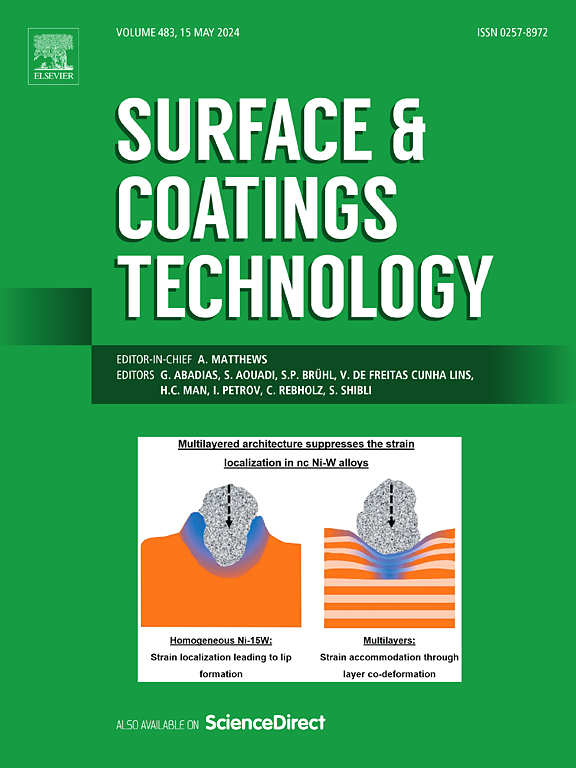The effect of nitrogen on the thermomechanical behavior of β-W thin films
IF 6.1
2区 材料科学
Q1 MATERIALS SCIENCE, COATINGS & FILMS
引用次数: 0
Abstract
The effect of nitrogen on the stress-temperature behavior of β‑tungsten thin films on silicon substrates was investigated. β-W thin films containing 2.2 to 6.8 at.% N were deposited using DC magnetron sputtering. Film stress was characterized in-situ during temperature cycles in vacuum using substrate curvature measurements. Two large irreversible tensile stress changes were seen in all films. Analysis of stress generation mechanisms revealed their origins. One, of nearly constant magnitude ~2.6 GPa, occurred at temperatures that increased with N content from 223 to 564 °C and was attributed to the density change of the β-α phase transformation indicating that higher nitrogen content enhances the thermal stability of β-W. The other occurred over a constant temperature range of 750–900 °C, increased in magnitude from 351 to 863 MPa with N content, and was attributed to nitrogen outgassing through grain boundary diffusion. Although grain growth was significant, contributions to stress were relatively minor. Knowledge of stress generation mechanisms facilitated construction of β-α phase transformation curves from the stress-temperature data. Analysis of these curves using a non-isothermal Johnson-Mehl-Avrami-Kolmagorov model indicates that the activation energy barrier for the phase transformation increases with the α phase volume fraction as well as with the initial nitrogen concentration, consistent with solute drag due to N at α/β phase boundaries. These thermomechanically-derived results are remarkably similar to prior results obtained using x-ray diffraction methods. These methods are compared, and implications for devices based on β-W are discussed.

氮对β-W薄膜热力学行为的影响
研究了氮对硅衬底β钨薄膜应力-温度行为的影响。β-W薄膜含有2.2至6.8 at。采用直流磁控溅射沉积了% N。利用衬底曲率测量方法,对真空温度循环过程中薄膜的应力进行了原位表征。所有薄膜均出现两个不可逆的大拉应力变化。对应力产生机制的分析揭示了其成因。在223 ~ 564℃,随着N含量的增加,β-α相变的密度发生了变化,这表明较高的氮含量增强了β- w的热稳定性。另一种发生在750 ~ 900℃的恒定温度范围内,随N含量的增加,强度从351 MPa增加到863 MPa,这是由于氮通过晶界扩散析出所致。虽然晶粒生长显著,但对应力的贡献相对较小。了解应力产生机制有助于从应力-温度数据构建β-α相变曲线。利用非等温Johnson-Mehl-Avrami-Kolmagorov模型对这些曲线进行分析表明,相变的活化能势垒随着α相体积分数和初始氮浓度的增加而增加,这与α/β相边界处N引起的溶质阻力一致。这些热力学推导的结果与先前使用x射线衍射方法得到的结果非常相似。对这些方法进行了比较,并讨论了基于β-W的器件的意义。
本文章由计算机程序翻译,如有差异,请以英文原文为准。
求助全文
约1分钟内获得全文
求助全文
来源期刊

Surface & Coatings Technology
工程技术-材料科学:膜
CiteScore
10.00
自引率
11.10%
发文量
921
审稿时长
19 days
期刊介绍:
Surface and Coatings Technology is an international archival journal publishing scientific papers on significant developments in surface and interface engineering to modify and improve the surface properties of materials for protection in demanding contact conditions or aggressive environments, or for enhanced functional performance. Contributions range from original scientific articles concerned with fundamental and applied aspects of research or direct applications of metallic, inorganic, organic and composite coatings, to invited reviews of current technology in specific areas. Papers submitted to this journal are expected to be in line with the following aspects in processes, and properties/performance:
A. Processes: Physical and chemical vapour deposition techniques, thermal and plasma spraying, surface modification by directed energy techniques such as ion, electron and laser beams, thermo-chemical treatment, wet chemical and electrochemical processes such as plating, sol-gel coating, anodization, plasma electrolytic oxidation, etc., but excluding painting.
B. Properties/performance: friction performance, wear resistance (e.g., abrasion, erosion, fretting, etc), corrosion and oxidation resistance, thermal protection, diffusion resistance, hydrophilicity/hydrophobicity, and properties relevant to smart materials behaviour and enhanced multifunctional performance for environmental, energy and medical applications, but excluding device aspects.
 求助内容:
求助内容: 应助结果提醒方式:
应助结果提醒方式:


